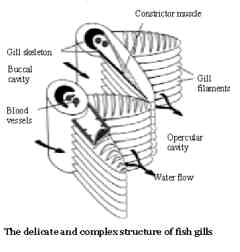Gills are vital to the health of koi
Fish gills are extremely susceptible to physical damage, parasite infections and bacterial infections. Unless caught early, gill disease is very difficult to resolve.
An understanding of the structure and function of the gill is helpful if we are to appreciate both the importance of gills and their susceptibility to disease. It is almost impossible to underestimate their importance to the health and well-being of koi -and anything that undermines their efficiency is likely to be harmful to both the fish’s immediate and long term health. While they are broadly equivalent to lungs in mammals, unlike mammalian lungs they are involved with other, equally important physiological functions.
The primary and best known function is ‘breathing’, or more correctly, gaseous exchange, during which oxygen diffuses into the bloodstream, while waste carbon dioxide is excreted into the water. In addition to gaseous exchange, they are involved in other vital processes such as metabolic ammonia excretion, during which ammonia produced by the breakdown of proteins is excreted directly into the surrounding water via the gills. Another important function is osmoregulation, a process that regulates the water and concentration of various solutes and ions, such as sodium and calcium, in the fish’s body.
Fish gill structure

The constant, essential exchange of metabolic wastes, oxygen and various solutes between fish and water is possible because of the distinctive structure of the gills. They have several rows of filaments attached to gill-arches, looking like the teeth of a comb These rows of filaments or primary lamellae present an enormous surface area (compared to the visible body surface) for excretion and diffusion to take place.
Easily damaged
There are two common ways in which the structure can be damaged. Filaments can be physically attacked, usually by bacteria or fungi, and ‘eaten away’, which will lead to a progressive loss of function.
The other, seemingly opposite, effect is hyperplasia in which the gill epithelium thickens in response to an irritant. In extreme cases the secondary filaments can club together. Any thickening of the epithelium will drastically reduce diffusion across it, while clubbing together of filaments will significantly reduce the overall surface area available for diffusion. The result of both these extremes is the same: loss of osmoregulatory function and ability to take up oxygen and excrete carbon dioxide. Needless to say, such consequences are stressful and life-threatening.
Despite its delicate structure, the gill has its protection. Covered by the thick, bony cover called the operculum, the filaments are protected against accidental knocks and physical damage and, in common with the rest of the body, they are also covered with a layer of mucus, which provides some protection from fungi, parasites and bacteria. Even so, the gills are a weak point which can be exploited by an outbreak of opportunistic organisms.
Hyperplasia
If ever there was a direct physical link between poor water quality and ill health, that link is the gills. Their delicate structure means that they are easily damaged by chemicals such as chlorine, ammonia, formalin and others, as well as by large changes in water pH value.
The initial response to chemical attack, or indeed any irritant, is usually hyperplasia, in which the epidermis thickens by producing extra cells. Often this thickening of the epithelium results in the secondary lamellae becoming stuck or clubbed together. Chronic irritation is also likely to cause a thickening of the mucous layer.
These conditions, together with the stress caused by the accompanying osmoregulatory and respiratory problems, are ideal for opportunist bacteria. If the condition is not treated and resolved it is very likely that secondary opportunistic bacteria, parasites or fungi will gain a foothold. And secondary infections can lead to gill-rot, during which the filaments are slowly eroded away, usually with fatal results.
While poor water quality is often a primary cause of problems, high levels of parasites such as gill/skin flukes, Trichodina and Costia, can be directly damaging. But remember that high levels of parasites are usually brought about by poor water conditions – and therein lies the root of most gill diseases.
Got a problem?
With a little knowledge it is fairly easy to surmise that there may be a problem. However, a firm diagnosis involves taking gill or mucus samples for microscopic examination. Fortunately, if caught early enough most problems respond to a fairly simple treatment. However, advanced cases are almost always fatal.
In the early stages, diagnosis can be difficult. Often, you may suspect that something is awry, yet the fish may look fit enough. However, there are likely to be distinct changes in behaviour. For example, the koi may sometimes avoid using a pectoral fin. Constant rubbing or ‘flashing’ may also indicate the presence of some irritant or parasite which, as already mentioned, may be the precursor of a more serious problem. The koi are likely to be less active than normal and less ready to take food. If there are no other obvious signs then remedial action – such as a short-term salt bath – taken at this early stage will often forestall a more serious problem.
As the condition (whatever the cause) progresses, the fish will have problems breathing. It is possible to judge the breathing rate by watching the movement of the operculum and making comparisons with a healthy fish. If the koi has gill problems the breathing rate is likely to be rapid and deep, as though the koi is panting. Afflicted fish are also likely to hang around where dissolved oxygen levels are highest – maybe near the water returns. The fish will become lethargic and not swim about, tending to remain in the same position for long periods, usually away from the others. Close examination may reveal that the operculum are flared or swollen and there may be strands of mucus trailing from under the operculum.
Remedial action
As a rule of thumb, it is better to err on the side of caution if a problem is suspected. A 10 to 15 minute, well-aerated salt bath at 10g salt per litre of water will help remove excess mucus and act against most ectoparasites. It may be necessary to repeat this the following day, if there is no improvement. If this does not resolve the problem then a physical examination is important to establish exactly what the problem is. As I have already mentioned, this means looking under the operculum to examine the condition of the filaments and it may also entail taking a biopsy (a small piece of filament) and mucus sample to check for the presence of bacteria and parasites. Healthy gills should be a uniform bright red and the filaments should be in a good clean condition without any obvious damage. If a gill problem is suspected, anaesthesia has to be carried out very carefully as any damage to the filaments may impair the ability of the fish to recover from the anaesthetic.
If a problem is suspected or confirmed following a physical examination – it is important that water quality is also checked. Raised levels of ammonia and nitrite can often initiate problems, as can extremes of pH. Many gill diseases are associated with water that has a high organic content. This usually comes about from over-feeding or insufficient pond and filter maintenance. Lots of decomposing matter in the pond or filter (remember they’re connected!) -encourage the proliferation of opportunistic organisms, so one of the first steps when a problem is suspected is to clean both the pond and filter thoroughly.

